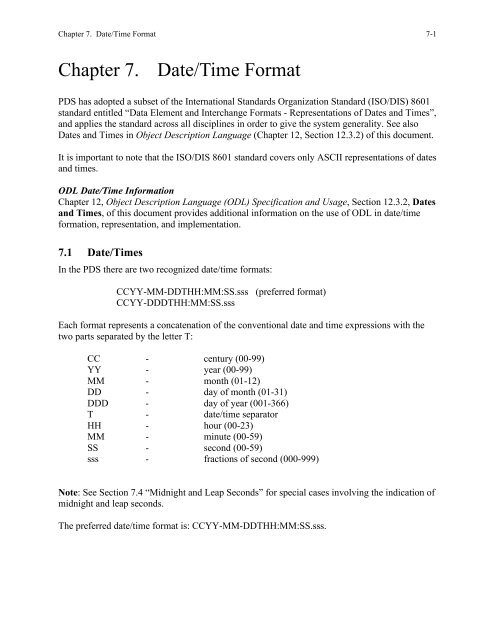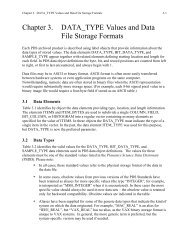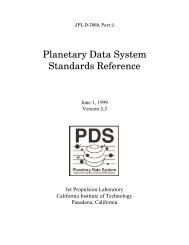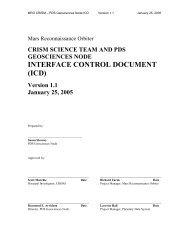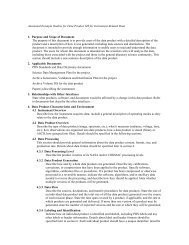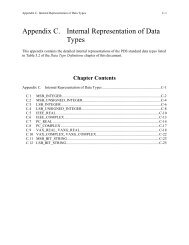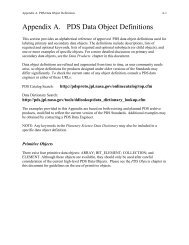Chapter 7. Date/Time Format - the Planetary Data System
Chapter 7. Date/Time Format - the Planetary Data System
Chapter 7. Date/Time Format - the Planetary Data System
You also want an ePaper? Increase the reach of your titles
YUMPU automatically turns print PDFs into web optimized ePapers that Google loves.
7-2 <strong>Chapter</strong> <strong>7.</strong> <strong>Date</strong>/<strong>Time</strong> <strong>Format</strong><strong>Date</strong>/<strong>Time</strong> PrecisionThe above date/time formats may be truncated on <strong>the</strong> right to match <strong>the</strong> precision of <strong>the</strong>date/time value in any of <strong>the</strong> following forms:19981998-121998-12-011998-12-01T231998-12-01T23:591998-12-01T23:59:581998-12-01T23:59:58.11998-12-01T23:59:58.12<strong>7.</strong>2 <strong>Date</strong>s<strong>Date</strong>s should be expressed in <strong>the</strong> conventional ISO/DIS 8601 format. On those rare occasionswhen dates cannot be expressed in <strong>the</strong> conventional format, a native format may be used.<strong>7.</strong>2.1 Conventional <strong>Date</strong>sConventional dates are represented in ISO/DIS 8601 format as ei<strong>the</strong>r year (including century),month, day-of-month (CCYY-MM-DD), or as year, day-of-year (CCYY-DDD). The hyphencharacter (‘-‘) is used as <strong>the</strong> field separator in this format. The year, month, day-of month formatis <strong>the</strong> preferred format for use in PDS labels and catalog files and is referred to as PDS standarddate format, but ei<strong>the</strong>r format is acceptable.<strong>7.</strong>2.2 Native <strong>Date</strong>s<strong>Date</strong>s in any format o<strong>the</strong>r than <strong>the</strong> ISO/DIS 8601 format described above are considered to be ina format native to <strong>the</strong> specific data set, thus “native dates”. Native date formats are specified by<strong>the</strong> data preparer in conjunction with <strong>the</strong> PDS data engineer. Mission-elapsed days and time-toencounterare both examples of native dates.<strong>7.</strong>3 <strong>Time</strong>sThe PDS allows times to be expressed in conventional and native (alternate) formats.<strong>7.</strong>3.1 Conventional <strong>Time</strong>sConventional times are represented as hours, minutes and seconds according to <strong>the</strong> ISO/DIS8601 time format standard: HH:MM:SS[.sss]. Note that <strong>the</strong> hours, minutes, and integral secondsfields must contain two digits. The colon (':') is used as a field separator. Fractional secondsconsisting of a decimal point (<strong>the</strong> European-style comma may not be used) and up to three digits(thousandths of a second) may be included if appropriate.Coordinated Universal <strong>Time</strong> (UTC) is <strong>the</strong> PDS time standard and must be formatted in <strong>the</strong>
<strong>Chapter</strong> <strong>7.</strong> <strong>Date</strong>/<strong>Time</strong> <strong>Format</strong> 7-3previously described ISO/DIS 8601 standard format. The letter "Z", indicating <strong>the</strong> civil timezone at Greenwich (i.e., GMT), should never be appended to a UTC time. The relationshipbetween UTC and GMT has varied historically and with observer context. Note that in PDS datasets created under earlier versions of <strong>the</strong> Standards, an appended “Z” is taken as indicating UTC.The START_TIME and STOP_TIME data elements required in data product labels and catalogfiles are in UTC. For data collected by spacecraft-mounted instruments, <strong>the</strong> date/ time must be atime that corresponds to “spacecraft event time”. For data collected by instruments not locatedon a spacecraft, this time shall be an earth-based event time.Adoption of UTC (ra<strong>the</strong>r than spacecraft-clock-count, for example) as <strong>the</strong> standard facilitatescomparison of data from a particular spacecraft or ground-based facility with data from o<strong>the</strong>rsources.<strong>7.</strong>3.2 Native <strong>Time</strong>s<strong>Time</strong>s in any format o<strong>the</strong>r than <strong>the</strong> ISO/DIS 8601 format described above are considered to be ina format native to <strong>the</strong> data set, and thus “native times”. The NATIVE_START_TIME andNATIVE_STOP_TIME elements hold <strong>the</strong> native time equivalents of <strong>the</strong> UTC values inSTART_TIME and STOP_TIME, respectively.There is one native time of particular interest, however, which has specific keywords associatedwith it. The spacecraft clock reading (that is, <strong>the</strong> “count”) often provides <strong>the</strong> essential timinginformation for a space-based observation. Therefore, <strong>the</strong> elementsSPACECRAFT_CLOCK_START_COUNT and SPACECRAFT_CLOCK_STOP_COUNT arerequired in labels describing space-based data. This value is formatted as a string to preserveprecision.Note that in rare cases in which <strong>the</strong>re is more than one native time relevant to an observation, <strong>the</strong>data preparer should consult a PDS data engineer for assistance in selecting <strong>the</strong> appropriate PDSelements.Examples of quantities that may be expressed in native time formats include:1. Spacecraft Clock Count (sclk)2. Ephemeris <strong>Time</strong>3. Relative <strong>Time</strong>4. Local <strong>Time</strong><strong>7.</strong>4 Midnight and Leap SecondsThe ISO/DIS 8601 standard for representation of midnight and leap seconds are also used inPDS time fields.
7-4 <strong>Chapter</strong> <strong>7.</strong> <strong>Date</strong>/<strong>Time</strong> <strong>Format</strong><strong>7.</strong>4.1 MidnightMidnight may be indicated in one of two ways: as “00:00:00” or “24:00:00”. The usualprecision modifications apply as well – i.e. “24:00” is also recognized as midnight.The “00:00:00” notation is used to indicate midnight at <strong>the</strong> beginning of a date. “24:00:00” isused to indicate midnight at <strong>the</strong> end of a date. So, for example, <strong>the</strong> following two date/timestrings refer to precisely <strong>the</strong> same moment:2007-04-07T24:00:00 = 2007-04-08T00:00:00When <strong>the</strong> hours field has <strong>the</strong> value “24”, any and all subsequent time fields must be zero.<strong>7.</strong>4.2 Leap SecondsLeap seconds may be positive or negative, but in ei<strong>the</strong>r case are always applied at <strong>the</strong> end of <strong>the</strong>day in question. A positive leap second is indicated with a time value of “23:59:60”. A negativeleap second is indicated by <strong>the</strong> omission of <strong>the</strong> time “23:59:59”. That is, on <strong>the</strong> day of a negativeleap second, <strong>the</strong> sequence leading through midnight is:23:59:5723:59:5800:00:0000:00:01And on <strong>the</strong> day of a positive leap second, <strong>the</strong> sequence through midnight is:23:59:5823:59:5923:59:6000:00:0000:00:01Note that <strong>the</strong> only time when <strong>the</strong> seconds value of a time string may contain <strong>the</strong> value “60” iswhen this represents a positive leap second.


